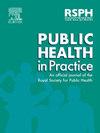Feasibility of establishing a Canadian Obstetric Survey System (CanOSS) for severe maternal morbidity: results of a nationwide survey
IF 1.9
Q2 PUBLIC, ENVIRONMENTAL & OCCUPATIONAL HEALTH
引用次数: 0
Abstract
Objective
Obtaining data on events, processes, and circumstances leading to severe maternal morbidity (SMM) could enable targeted interventions to improve care. We aimed to assess the feasibility of gathering such data from across Canada through an Obstetric Survey System (CanOSS).
Study design
A nationwide survey.
Methods
We administered the electronic survey in French or English to birthing unit leads across all Canadian provinces and territories using REDCap. We presented pooled participation rates (95 % confidence intervals [CI]) across birthing units from lowest, medium, and highest tiers of service using Freeman-Tukey double arcsine transformations and common-effect models.
Results
Of the 289 birthing units across Canada, 167 (57.8 %) participated in the survey. Pooled participation rates per province and territory stratified by highest, medium, and lowest tiers of service were 91.5 % (95 % CI [73.4, 100]), 58.6 % (95 % CI [48.5, 68.6]), and 54.4 % (95 % CI [41.7, 66.3]), respectively. Units reported postpartum hemorrhage (82.5 %), hypertensive disorders (65.7 %), infections (35.0 %), venous thromboembolism (16.0 %), and maternal birth injuries (15.4 %) as the leading causes of SMM. Most birthing units (80.3 %) had a system in place for reviewing SMM events. Although most review systems involved multidisciplinary expert panels with representation from birthing unit leads (82.0 %), nursing (78.0 %), and obstetrics (73.7 %), specialties, such as obstetric anaesthesia (42.4 %), midwifery (41.5 %), and internal medicine (16.9 %), were underrepresented. Lessons learned were rarely shared outside the hospital and never shared beyond regional health authorities. Importantly, 76.2 % of respondents were willing to contribute anonymized SMM data within a centralized reporting system.
Conclusions
Most responding Canadian birthing units have a process in place to review SMM and would be willing to share anonymized data as part of a centralized initiative, thereby demonstrating the feasibility of leveraging existing infrastructures to establish CanOSS.
建立加拿大严重产妇发病率产科调查系统(CanOSS)的可行性:一项全国性调查的结果
目的获取导致严重孕产妇发病率(SMM)的事件、过程和情况的数据,可以使有针对性的干预措施改善护理。我们的目的是评估通过产科调查系统(CanOSS)从加拿大各地收集此类数据的可行性。研究设计:全国性调查。方法使用REDCap对加拿大所有省份和地区的分娩单位进行法语或英语电子调查。我们使用Freeman-Tukey双反正弦变换和共同效应模型,从最低、中等和最高服务等级的分娩单位中得出了汇总参与率(95%置信区间[CI])。结果在加拿大289个分娩单位中,167个(57.8%)参加了调查。按最高、中等和最低服务等级划分的每个省和地区的总参与率分别为91.5% (95% CI[73.4, 100])、58.6% (95% CI[48.5, 68.6])和54.4% (95% CI[41.7, 66.3])。各单位报告称,产后出血(82.5%)、高血压疾病(65.7%)、感染(35.0%)、静脉血栓栓塞(16.0%)和产妇分娩损伤(15.4%)是SMM的主要原因。大多数分娩单位(80.3%)有一个审查SMM事件的系统。尽管大多数审查系统涉及多学科专家小组,包括来自分娩单位领导(82.0%)、护理(78.0%)和产科(73.7%)的代表,但产科麻醉(42.4%)、助产(41.5%)和内科(16.9%)等专业的代表不足。吸取的经验教训很少在医院外分享,也从未在地区卫生当局之外分享。重要的是,76.2%的受访者愿意在集中报告系统中提供匿名的SMM数据。大多数回应的加拿大分娩单位都有一个审查SMM的过程,并且愿意将匿名数据作为集中倡议的一部分共享,从而证明利用现有基础设施建立CanOSS的可行性。
本文章由计算机程序翻译,如有差异,请以英文原文为准。
求助全文
约1分钟内获得全文
求助全文

 求助内容:
求助内容: 应助结果提醒方式:
应助结果提醒方式:


